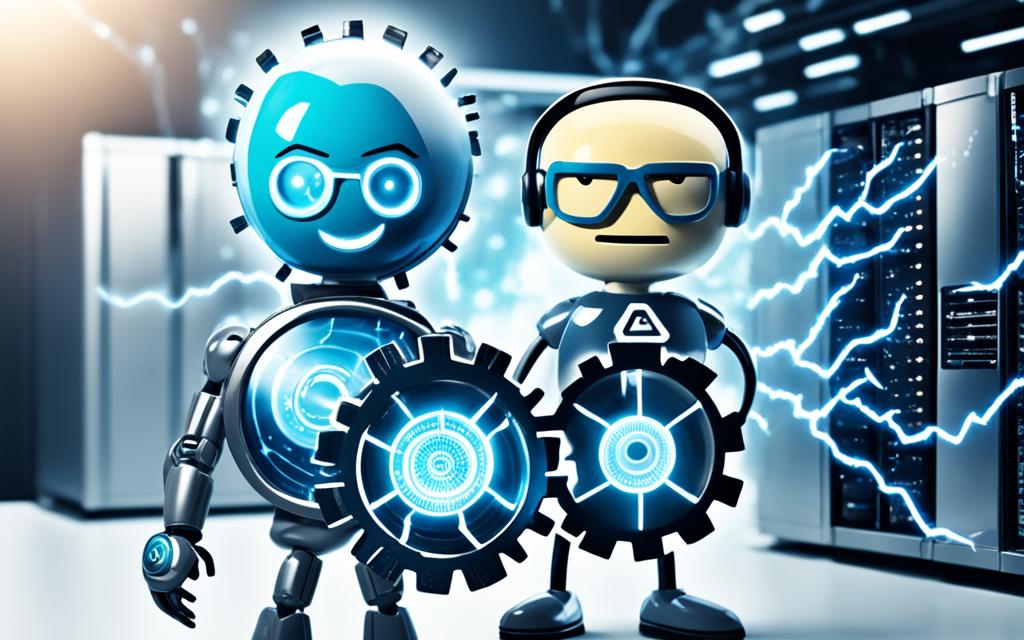Table of Contents
In today’s tech world, knowing how compute and storage differ is key. Both are crucial in cloud computing, affecting how companies operate and handle data. Compute resources let systems perform tasks with their processing power.
On the other hand, storage resources deal with keeping huge amounts of data. This article aims to delve deeper into these distinct areas. It highlights their roles and how they’re applied. As firms aim for better data storage, understanding these differences is vital.
The path to top performance starts by exploring compute resources. We’ll also look at how storage solutions ensure a smooth computing experience. For guidance on choosing the best for your needs, visit this resource1.
Key Takeaways
- Understanding compute vs storage is vital for enhancing business performance.
- Compute resources focus on processing power, while storage resources focus on data management.
- Cloud computing offers flexibility and scalability in both compute and storage solutions.
- The choice between compute and storage should align with specific operational needs.
- Each area has distinct capabilities that directly impact overall system performance.
Understanding Compute Resources
In today’s digital age, getting to grips with compute resources is key. These elements are crucial for task execution and app running in IT setups. They ensure everything works smoothly and effectively.
Definition of Compute Resources
At their core, compute resources include processing ability, memory, and network access. They’re vital for cloud computing, enabling fast calculations and command execution. Without them, coping with digital needs and growing data volumes would be tough for businesses.
Types of Compute Services
There are several compute services designed for varying business requirements. Each offers a different level of management. Below are a few:
- Infrastructure-as-a-Service (IaaS): This is about flexible, scalable resources like virtual machines.
- Platform-as-a-Service (PaaS): Offers a platform for app development, freeing developers from infrastructure concerns.
- Software-as-a-Service (SaaS): Lets users access software apps online without needing to install them.
Knowing these service types helps companies pick what best fits their needs.
Benefits of Cloud Computing
Cloud computing changes the game for accessing compute resources. The advantages are clear:
- Accessibility: Supports remote access, boosting teamwork.
- Scalability: Offers resource adjustment as per demand, aiding in growth.
- Cost-Efficiency: Cuts down on the IT infrastructure needed, saving money.
These perks are key to a flexible and up-to-date IT system, ready for future tech shifts.
To learn more about compute resources, take a look at this detailed resource. Constantly exploring and adapting compute services boosts efficiency and sparks innovation234.
The Role of Storage in Computing
In this digital age, storing data well is key to strong data management. Knowing the different storage options is crucial for companies wanting to work smoothly. Let’s look into what storing data means, check out the storage types, and talk about why it’s important to get to your data easily.
What is Data Storage?
Data storage is about keeping and looking after data to use it later. It’s essential for making sure info is there when you need it. Good storage plans help a company run better, letting them get to important data fast for decisions and day-to-day work.
Types of Data Storage Solutions
There are many storage solutions, each designed for different needs:
- Local Storage: Uses devices like hard drives to keep data.
- Cloud Storage: Offers a scalable, flexible way to save on physical data centre costs5.
- Object Storage: Keeps data as objects, great for unstructured data.
- Block Storage: Works well at a basic level, perfect for database needs.
- File Storage: Arranges data easily, good for sharing and getting to it.
Importance of Data Accessibility
Being able to reach your data easily is super important. Companies need strong storage to make sure data is always there, helping them make better choices and work together well. Easy access to data boosts how well a company operates, leading to new ideas and better performance5. Also, as companies choose cloud solutions for their value and scale, managing data wisely stands out even more in the race to the top5.
Comparing Compute vs. Storage
In today’s tech world, it’s crucial to know how compute and storage differ. Compute resources are for processing and running tasks. Meanwhile, storage resources keep data safe and accessible. We’ll look into what sets them apart and why each matters.
Key Differences Explained
Compute resources handle the running of applications and processing data. They use virtual machines and containers to power various apps smoothly. On the other hand, storage resources look after data management and safety. Services like Amazon AWS, Microsoft Azure, and Google show how important storage is in the cloud6.
Keeping compute and storage separate lets organisations grow quickly. Database clusters can expand in seconds, unlike old systems that take much longer7. This division shows how closely linked compute and storage are in improving how things work.
Performance Considerations
Choosing between compute and storage needs careful thought about performance. Speed, latency, and throughput are key to system efficiency and user happiness. Cloud services aim for low latency and high bandwidth for quicker access to data7.
Sometimes, storage latency might not be a big deal, like with complex data queries. Cloud data centres’ strong networks help ease latency problems. This makes getting data smoother7.
Types of Compute and Storage Architectatures
Knowing the different architectures of compute and storage is crucial for informed choices in cloud computing. Each type offers unique advantages for various business needs. We’ll look into Infrastructure-as-a-Service (IaaS), Platform-as-a-Service (PaaS), Software-as-a-Service (SaaS), and the differences between object storage, block storage, and file storage.
Infrastructure-as-a-Service (IaaS)
IaaS offers the basic building blocks for cloud setups, providing virtual computing resources online. It lets users adjust their infrastructure as needed without managing physical hardware. This flexibility means companies can quickly meet changing needs, making IaaS a favorite for those after efficiency and saving costs.
Because you can get more storage and compute power on demand, IaaS is great for variable workloads.
Platform-as-a-Service (PaaS)
PaaS makes developing applications easier by providing a platform. This lets developers focus on coding rather than on handling servers. With tools and databases included, PaaS speeds up creating and managing applications.
Software-as-a-Service (SaaS)
SaaS offers software over the cloud, which cuts down on the need for users to install and update programs. It allows access from any internet-connected device. The subscription model of SaaS is budget-friendly, letting companies use the newest software without big initial costs.
Object, Block, and File Storage
The three main storage types – object, block, and file storage – serve various data management needs.
- Object Storage: Uses a flat structure ideal for unstructured data like multimedia. It provides vast scalability and durability.
- Block Storage: Offers low latency, fitting for database-driven apps needing fast access. High-speed connections like Fibre Channel or iSCSI give optimized performance for apps and virtual machines8.
- File Storage: Works well for shared files in a network. It’s useful where many users need access to the same data8.
New storage architectures like hyper-converged storage improve resource use and the scalability. This leads to more efficient data handling9.
Use Cases for Compute and Storage Solutions
When organisations plan their IT, knowing how to use compute resources and storage is key. This helps them get the best performance and save costs. Different needs lead to different choices.
When to Choose Compute Resources
Choosing the right compute resources is crucial for tasks needing high processing power. For example, apps needing real-time analytics require a lot of compute power quickly. Projects that process a lot of data also depend on strong compute capabilities. Some uses are:
- High-demand applications, like financial models or games, where fast performance matters.
- Real-time data analysis that helps make better decisions.
- Machine learning tasks that do lots of calculations and train models.
When to Choose Storage Solutions
Choosing storage solutions is important when your data strategy must match your organisation’s needs. If you have a lot of unstructured data or need quick data access, good storage solutions are vital. Key times to use storage include:
- Archiving data, where keeping records is important but instant access isn’t needed.
- Handling lots of unstructured data, requiring scalable and adaptable storage.
- Needing fast data access for your day-to-day work, making how you can get to your data very important.
Knowing these different needs helps organisations plan their IT well. This ensures they choose the right mix of compute power and storage. This helps them meet their needs and work better.
| Use Case Type | Compute Resources | Storage Solutions |
|---|---|---|
| Real-time Analytics | High processing speed needed | Not a primary focus |
| Data Archiving | Limited compute requirements | Essential for long-term access |
| Unstructured Data Management | Variable processing needs | Scalable storage necessary |
| Machine Learning | Intensive compute required | Data storage critical for models |
Understanding these points helps make sure resources are used well. It allows organisations to manage their needs effectively. This careful planning can save money and improve how they work. It shows how important it is to match resources with business goals1011.
Conclusion
Exploring compute vs storage shows their vital link in IT strategy. Knowing their differences helps organisations shape their systems for better outcomes. They achieve enhanced app performance and scalability.
A well-mixed compute and storage setup boosts operations and sparks innovation. Using both wisely helps businesses stay ahead in fast-changing markets. Key insights from Atlassian highlight the benefits of cloud computing in this mix, improving speed and efficiency.
The right investment in compute and storage pays off by cutting costs and boosting flexibility. As the digital world grows, using both resources smartly is key for ongoing success and growth121314.
FAQ
What are compute resources?
Compute resources include processing power, memory, and network support. They are key for running tasks and applications within IT environments.
How do cloud computing benefits impact businesses?
Cloud computing offers key advantages like better accessibility and scalability. It also makes operations more cost-efficient. This allows organisations to adjust their resources based on demand, which benefits them in the short and long term.
What is data storage and why is it important?
Data storage involves keeping data safe for future use. It’s key in any digital landscape. This ensures data is always ready to help with decisions and improve business operations.
What are the main types of data storage solutions?
There are various data storage options like local, cloud, object, block, and file storage. Each has its own uses and benefits in business settings.
What are the key differences between compute and storage resources?
Compute resources deal with processing and running applications. Storage resources focus on keeping information organised for easy access.
When should an organisation choose compute resources over storage solutions?
Organisations need more compute power for demanding apps and large data analysis. This helps manage tasks efficiently, especially when real-time analytics are needed.
Can you explain the types of compute services available?
There are three main compute services. Infrastructure-as-a-Service (IaaS) gives vital computing resources. Platform-as-a-Service (PaaS) lets developers create applications. Software-as-a-Service (SaaS) offers cloud-based apps with less need for users to manage infrastructure.
Why is data accessibility considered crucial?
Easy access to data boosts efficiency, aiding in decision-making and teamwork. Strong storage solutions that provide quick data access are essential for productivity.
What performance metrics should be considered for compute and storage solutions?
Evaluating speed, latency, and throughput is important. These metrics influence system efficiency and the user experience, helping to choose the right solutions.
Source Links
- https://cloudian.com/blog/object-storage-vs-file-storage/ – Object Storage vs. File Storage: What’s the Difference? – Cloudian
- https://cloudacademy.com/blog/aws-fundamentals/ – AWS Fundamentals: Understanding Compute, Storage, Database, Networking & Security
- https://bluexp.netapp.com/blog/understanding-aws-high-availability-compute-sql-and-storage – Understanding AWS High Availability: Compute, SQL and Storage
- https://medium.com/307tocloud9/the-pillars-of-the-cloud-exploring-compute-storage-databases-and-networking-part-2-11-a8490bcd9e9e – The Pillars of the Cloud: Exploring Compute, Storage, Databases, and Networking (Part 2/11)
- https://www.purestorage.com/br/knowledge/cloud-computing-vs-cloud-storage.html – Cloud Computing vs. Cloud Storage | Pure Storage
- https://www.cyberlinkasp.com/insights/difference-cloud-storage-cloud-computing/ – The Difference Between Cloud Storage and Cloud Computing
- https://ajstorm.medium.com/separating-compute-and-storage-59def4f27d64 – Separating compute and storage
- https://www.xbyte.com/blog/understanding-the-three-common-storage-architecture-types/ – Understanding the Three Common Storage Architecture Types
- https://e.huawei.com/en/blogs/storage/2023/technology-prospect-storage-compute-architecture – Storage-Compute Architecture & Data-Centric Computing | Huawei Enterprise
- https://telnyx.com/resources/cloud-computing-vs-cloud-storage – Cloud computing vs cloud storage: Key facts and insights
- https://www.propeldata.com/blog/what-is-the-separation-of-storage-and-compute-in-data-platforms-and-why-does-it-matter – What is the separation of storage and compute in data platforms and why does it matter?
- https://www.geeksforgeeks.org/difference-between-memory-and-storage/ – Difference between Memory and Storage – GeeksforGeeks
- https://medium.com/google-cloud/efficient-bigquery-data-modeling-a-storage-and-compute-comparison-ca7f3744e467 – Efficient BigQuery Data Modeling: A Storage and Compute Comparison
- https://proton.me/blog/cloud-storage-vs-physical-storage – Pros and cons of cloud storage vs. physical storage | Proton








